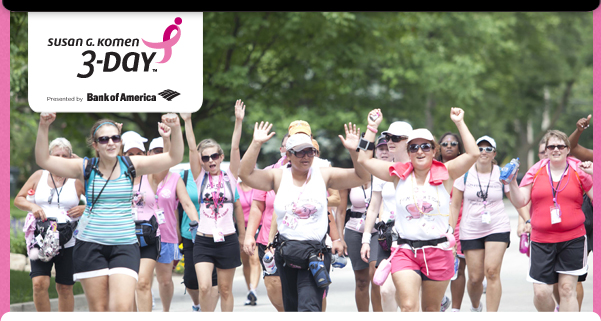 |
Countdown: 7 Weeks
Susan G. Komen 3-Day™ would like to thank New Balance, the official training partner of the 3-Day, for sponsoring the Virtual Personal Trainer.
Your 16-Week Training Schedule for This Week
| Monday |
|
Rest |
|
|
| Tuesday |
|
5 miles |
|
Easy walking |
| Wednesday |
|
45 minutes |
|
Moderate cross-training |
| Thursday |
|
6 miles |
|
Moderate walking |
| Friday |
|
45 minutes |
|
Easy cross-training |
| Saturday |
|
17 miles |
|
Easy walking |
| Sunday |
|
13 miles |
|
Easy walking |
Skip to Your Fundraising Step of the Week: Set Out a Super Change Jar
Training Tip of the Week: Lateral Knee Pain
“I have a burning pain on the outside of my knee.”
“I hear a snapping sound on the outside of my knee.”
“I have pain on the lateral aspect of my knee every time I walk over 2 miles.”
If you have these symptoms you may have Iliotibial Band Syndrome. The iliotibial band is a layer of connective tissue. It begins at a muscle near the outer side of your hip, travels down the outer side of your thigh, crosses the outer side of the knee and attaches to the outer side of your upper shin bone (tibia).
How does it occur?
ITB syndrome occurs when this band repeatedly rubs over the bump of the thigh bone (femur) near the knee causing the band to be irritated. This condition can result from:
- Having a tight iliotibial band.
- Having tight muscles in your hip, pelvis or leg.
- Your legs not being the same length.
- Walking on sloped surfaces.
- Walking in shoes with a lot of wear on the outside of the heel.
How is it treated?
Treatment includes the following:
- Walking, cycling and other exacerbating activity should be avoided.
- Apply an ice pack over the lateral knee for 15-20 minutes 3 times a day for 3 days or ice massage your knee. Freeze water in a paper cup. Peel the top of the cup away to expose the ice and hold the bottom of the cup while you rub the ice over your knee for 5 to 10 minutes.
- Take an anti-inflammatory medication, such as ibuprofen (do not take more than the recommended dose) for 3-7 days.
- Once the acute pain phase has decreased, start stretching exercises (see below). Stretches should be performed holding each position for 15 seconds, coming up to the starting position and repeating three times. If your symptoms do not improve, seek medical advice.

Your Fundraising Step of the Week: Set Out a Super Change Jar
Looking for a new, creative way to fundraise? Decorate an empty pickle jar with inspirational quotes and photos from your training walks. Put the jar on your desk at work. Also, ask all of your friends and family to put aside their spare change to be added to the jar. Keep a running total on the jar, so people can see how even a small donation can make a difference.
 |
 |
New Balance Training Corner: Lateral Knee Pain
Achy breaky knees? “Doctor New Balance” is making excellent happen with a quick diagnosis and recovery.
|
| Pain on the outside of the knee sounds like iliotibial band syndrome (ITBS) which occurs when the band repeatedly rubs over the bump of the thigh bone near the knee causing the band to be irritated. Avoid high intensity activity, apply ice over the lateral knee, take an anti-inflammatory and start stretching once the acute pain decreases. Listen to the doc and continue on with your walk! |
P.S. Click here to add a daily training reminder to your Outlook calendar.
NOTE: Each 3-Day® participant is solely responsible for all fundraising efforts in connection with his or her participation in the 3-Day, including compliance with all applicable laws. Before fundraising, be sure that your fundraising idea or event complies with all applicable rules and laws.
NOTE: The health, safety and training information provided to you in connection with your participation in the 3-Day is not intended to replace or be construed as medical advice and any such information is not a substitute for seeking medical advice or treatment from your medical provider. Before starting any exercise program or following any recommendations, advice or other instructions regarding training for the 3-Day, you should first consult a physician and have a physical examination.
|
 |





